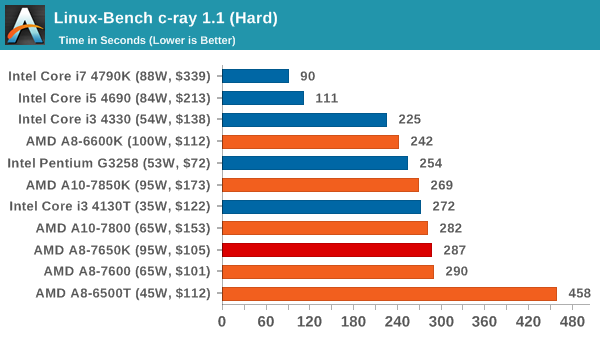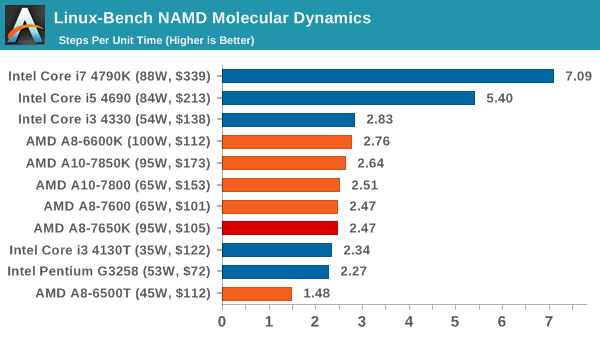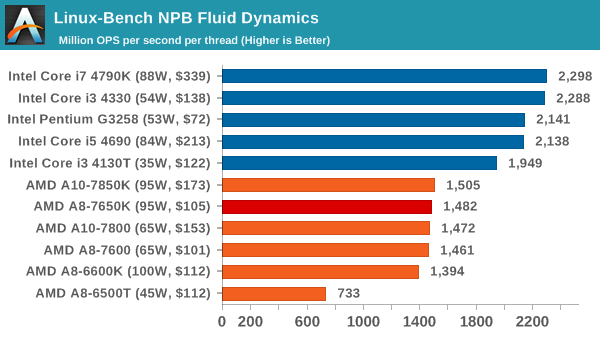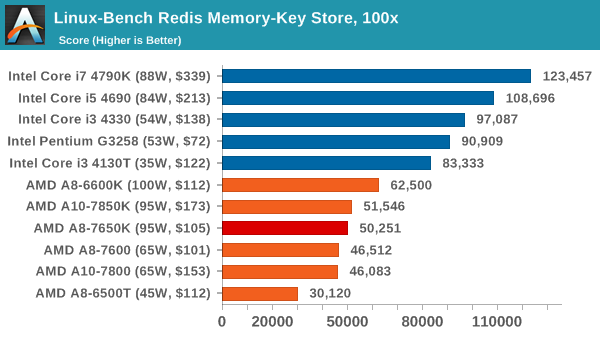The AMD A8-7650K APU Review, Also New Testing Methodology
by Ian Cutress on May 12, 2015 10:00 AM ESTProfessional Performance: Linux
Built around several freely available benchmarks for Linux, Linux-Bench is a project spearheaded by Patrick at ServeTheHome to streamline about a dozen of these tests in a single neat package run via a set of three commands using an Ubuntu 11.04 LiveCD. These tests include fluid dynamics used by NASA, ray-tracing, OpenSSL, molecular modeling, and a scalable data structure server for web deployments. We run Linux-Bench and have chosen to report a select few of the tests that rely on CPU and DRAM speed.
C-Ray: link
C-Ray is a simple ray-tracing program that focuses almost exclusively on processor performance rather than DRAM access. The test in Linux-Bench renders a heavy complex scene offering a large scalable scenario.

Being a scaling benchmark, C-Ray prefers threads and seems more designed for Intel.
NAMD, Scalable Molecular Dynamics: link
Developed by the Theoretical and Computational Biophysics Group at the University of Illinois at Urbana-Champaign, NAMD is a set of parallel molecular dynamics codes for extreme parallelization up to and beyond 200,000 cores. The reference paper detailing NAMD has over 4000 citations, and our testing runs a small simulation where the calculation steps per unit time is the output vector.

NAMD is similar to our office benchmarks, puttin the bulk of the APUs between the i3-4130T and the i3-4330.
NPB, Fluid Dynamics: link
Aside from LINPACK, there are many other ways to benchmark supercomputers in terms of how effective they are for various types of mathematical processes. The NAS Parallel Benchmarks (NPB) are a set of small programs originally designed for NASA to test their supercomputers in terms of fluid dynamics simulations, useful for airflow reactions and design.

Despite the rated memory on the APUs being faster, NPB seems to require more IPC than DRAM speed.
Redis: link
Many of the online applications rely on key-value caches and data structure servers to operate. Redis is an open-source, scalable web technology with a b developer base, but also relies heavily on memory bandwidth as well as CPU performance.











177 Comments
View All Comments
silverblue - Tuesday, May 12, 2015 - link
I heard a rumour that AMD were unable to meet demand and as such failed to secure a contract with Apple. Make of that what you will. As it was, Llano went from being under-produced to the exact opposite.galta - Tuesday, May 12, 2015 - link
Exactly: not only have they devised a poor strategy, they were also unable to follow it!V900 - Tuesday, May 12, 2015 - link
Nah, Llano would have been way too hot for an Apple laptop. Heck,'the CPU/GPU in a MacBook Air has a tdp of 15watt. Does AMD have anything even close to that, that doesn't involve Jaguar cores?galta - Tuesday, May 12, 2015 - link
Again, they were not able to deliver their strategy, even if it was a poor one.One says that integrated GPU is the future. That, per se, is questionable.
Later, we find out that they can't meet production orders and/or deliver a chip that is too hot for one of its potential markets. This is poor implementation.
Teknobug - Tuesday, May 12, 2015 - link
Enjoying my i3 4010U NUC as well, all I need for daily use and some occasional light gaming on Steam (I run Debian Linux on it).nerd1 - Tuesday, May 12, 2015 - link
Yoga 3 pro with 4.5W Core M got 90 points in Cinebench R15 Single-Threaded testThis 95W chip got 85 points in Cinebench R15 Single-Threaded test
So who's gonna buy this at all?
takeship - Tuesday, May 12, 2015 - link
Cynically, AMD may consider it better to have *any* product to discount/write-off down the road rather than fork over another wafer agreement penalty to GloFo with nothing to show for it.BrokenCrayons - Wednesday, May 13, 2015 - link
I noticed that as well, but the fact that this is a 95 watt processor isn't that much of a concern when you have the power envelope of a desktop chassis at your disposal. The intended niche for these APUs seems more to make a value proposition for budget gaming in a low-complexity system (meaning lacking the additional PCB complexity introduced by using a discrete GPU). Unfortunately, I don't see OEMs really putting any weight behind AMD APUs by selling systems containing them which leaves much of the sales up to the comparatively few people who DIY-build desktop hardware. Even those people are hard-pressed to find a lot of value in picking an APU-based platform over competing Intel products as they tend to have a little more budget flexibility and are targeting greater GPU performance than the A-series has available, putting them into discrete graphics solutions.zodiacfml - Wednesday, May 13, 2015 - link
The APU has more cores than that. In the test, did it tell you how much power it is using?yannigr2 - Tuesday, May 12, 2015 - link
Those two more and much more expensive Intel CPUs on the charts, make APUs look totally pathetic. Yes you do have the prices next to the charts, yes they do make APUs, look extremely valuable in the 3D games, but most people probably would not go past the first 4-5 pages in this article having being totally disappointed from the first results. Also the long blue lines will imprint in their memories, they will forget the prices.Next time throw a few Xeon e7 in the charts.
PS. PLEASE PLEASE PLEASE, don't turn to Tom's Hardware.